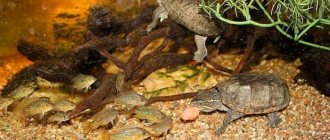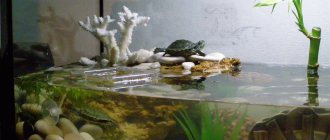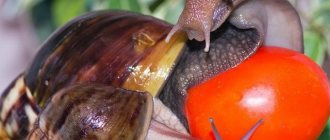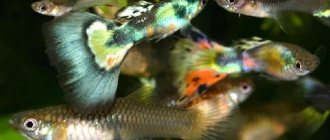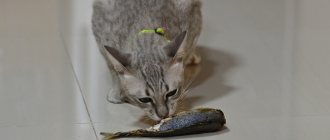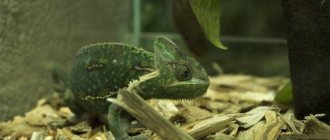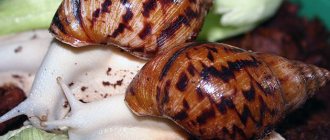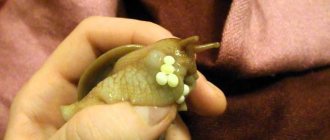Types of aquatic pet turtles
There are several varieties of small reptiles that can be kept in an aquarium at home. The most common small aquatic pet turtles are:
- Red-eared. The most common type of armored reptile for aquarium keeping. The miniature size of the animal is deceptive, since after 5-6 years it can reach 30-35 cm, depending on the sex. This breed of turtle is distinguished by the presence of a red stripe on its cheek and a calm character.
- Spotted. It belongs to the semi-aquatic species and has color features in the form of yellow spots randomly covering the neck, head and shell. The remaining parts of the animal's body are black. The average size of a spotted turtle is 10 cm. The ideal living conditions for this breed are an even distribution of water and land in the aquarium.
- Musky. It is considered the best reptile option for keeping at home. It is characterized by low susceptibility to infectious diseases and reaches 10-11 cm in length. This breed of aquatic turtle does not reach a larger size.
- Bolotnaya. A small turtle about 10 cm long can live up to half a century in captivity. This breed is not exotic, as it is found in ponds, lakes and river backwaters. When purchasing such a wild turtle, it is important to initially pick it up by the base of its shell in order to avoid manifestations of aggression.
- Locking turtles , the average length of which is from 11 to 13 cm, depending on the subspecies.
- Reeves' reptile. This pond turtle has rectangular plates on its shell. They grow up to 12 cm, but are not particularly popular among breeders due to frequent diseases caused by poor adaptation to the new environment.
- Flat. A small turtle up to 9 cm in length, unpretentious in nutrition; simple succulent plants are considered a favorite delicacy of this species.
Red-eared turtles
When purchasing a reptile, you should make sure that you are getting exactly the species that you wanted.
Otherwise, there is a risk of buying a representative of a different species instead of a dwarf turtle, which will later grow to large sizes.
Possible problems with improper care
If you care for your turtle incorrectly, the animal may get sick. Most often, diseases in such pets manifest themselves with symptoms such as:
- lack of appetite;
- crooked or soft shell;
- constantly closed or swollen eyes;
- runny nose;
- peeling of the skin.
A sick animal becomes inactive, begins to spend more time on land, and refuses food. In such cases, you should immediately consult a professional doctor. To treat a turtle, you will have to look for a specialist who knows how to treat such pets, because it is very difficult to diagnose them.
If well cared for, a domestic red-eared slider can live for about forty years. To do this, it is necessary to provide her with the right living conditions.
- Features of the Maine Coon cat breed
- Hunting with a Jag Terrier: double pleasure
Positive aspects of keeping at home
Since the reptile does not require constant attention from the owner, even very busy people can afford to have this representative of the fauna. Decorative aquatic turtles have long been loved not only by adults, but also by children. They do not require regular walks in any weather, do not cause allergic reactions, do not create noise and do not stain furniture.
It is enough to provide the amphibian pet with the necessary conditions in the aquarium and follow the correct feeding regimen.
Care and maintenance of aquarium turtles
Reptiles spend most of their time in water, so it is necessary that turtles be kept only in a specially equipped aquarium. It is not recommended to let your pet go for a walk around the apartment, as this is fraught with colds and injuries. The main condition for arranging an aquarium is to create the most natural environment for the turtle.
Requirements for an aquarium
When purchasing and arranging a home for a future pet, it is important to adhere to the following rules and conditions:
- The size of a house for an aquatic turtle should be at least 3 times the size of the animal itself. Reptiles love space, so it is advisable to purchase a larger aquarium.
- Only half of the glass house is filled with water ; special rough pebbles or branches should be installed at the bottom of the aquarium so that the turtle can crawl onto land in the form of an island, which is necessary to organize it.
- To warm up an area of land to 30-35 degrees , which is a comfortable temperature for a reptile, you should install a special lamp aimed precisely at the heated island.
- A thermometer must be installed inside the aquarium to avoid overheating and hypothermia. Both of these conditions are detrimental to the turtle.
- Among other accessories in the house there should be a UV lamp. Ultraviolet light is necessary for reptiles, since it helps them absorb calcium, which is necessary for the normal functioning of the body. The lamp should work throughout the daylight hours, at least 12 hours.
Little turtle
In addition to the requirements for the aquarium, there are some conditions for the water in which the turtle will be kept. Under no circumstances should you fill a glass house with tap water. It must sit for at least 24 hours.
Keeping in an aquarium
A water turtle at home should always be kept in an aquarium, except during water changes and cleaning. The water in the glass house should be changed 2 times a week, first allowing the new portion to sit for 24 hours.
The main condition in how to care for a reptile is to maintain a comfortable water temperature in the aquarium for it; it should be about 25 degrees, which is monitored with a regular thermometer.
It is not recommended to place a bowl of food either at the bottom of the home or on a sushi island. This will lead to rapid rotting and spoilage of water. It is better to organize feeding your pet outside the aquarium.
It is also not recommended to put sand on the bottom of the glass house, as this will make it difficult to clean the aquarium.
Fish compatibility
When purchasing small aquatic turtles, most aquarists are sure that these reptiles are compatible with any fish. However, aquarium turtles that live with fish are very rare, since most representatives of such reptiles are predators. This is especially true for the species of red-eared turtles, which feed on small fish and seafood.
Keeping fish together with an aquatic turtle in the same aquarium poses a significant danger to the fish. The only type of reptile that can get along with fish in the same aquarium is Trionics, however, this turtle is also a predator and poses a threat to some species of fish.
sushi island
The size of this island depends on the size of your pet. It should fit completely there freely. It is necessary to take into account that the island must be shaped in such a way that the water flowing from the turtle does not stagnate on it. It must be made of non-slip materials. Today, such islands can be offered to you in pet stores. This will save your time on its construction.
An aquarium requires a water purification filter and an ultraviolet lamp. Without ultraviolet light, turtles do not absorb calcium well. The bottom of the aquarium is laid out with pebbles or coarse soil. The reptile will definitely taste the soil with its teeth, so the size of the pebbles should be larger than the turtle’s head. When purchasing, find out what breed it belongs to. The temperature of the water in the aquarium depends on this.
What do aquatic turtles eat at home?
Proper and varied nutrition is the key to a healthy and long life for turtles. If the size of the pet does not exceed 10 cm, then it should be fed no more than once a day; if the size of the animal is more than 10 cm, the reptile should be given food no more than once every 3 days.
Red-eared turtles in the sun
Aquarium aquatic turtles need the following foods:
- raw vegetables - zucchini, carrots, cucumber;
- raw seafood - low-fat fish, shrimp and mussels;
- fruits - apples, bananas and pears;
- amphibians, preference should be given to tadpoles;
- greens - clover, alfalfa, mint and dandelion leaves;
- raw meat - only beef or chicken;
- snails, slugs, beetles.
To supplement their diet, turtles need mineral supplements, which can be purchased at pet stores. You can also give special dry food there, but it is not advisable to feed the reptile only with it, since to properly feed the turtle it is necessary to have natural food rich in vitamins and nutrients.
Land turtles
The most common type of domestic turtle is the Central Asian, which can be purchased without any problems at any pet store. The homeland of such turtles is the deserts and steppes of Asia. Therefore, they are sometimes called steppe . The shell of the land turtle is yellow-brown in color, and its length is from twenty to thirty centimeters. Reptiles have four toes on their front paws.
Interesting: How do snakes mate? Mating Features
Living conditions, feeding and bathing
For land turtles, a terrarium is usually prepared, but if one is not available, an ordinary cardboard box or plastic container will do.
The bottom of the container is covered with clean hay or sawdust . It is not recommended to use soil or sand. In order for the turtle to periodically grind down its claws, it is worth placing several large stones in the terrarium.
The terrarium must be equipped with an infrared heater or incandescent lamp. To prevent the turtle from suffering from lack of sunlight, you should install an ultraviolet lamp.
Turtles do not really like attention to them and often hide. Therefore, you can build a “house” for them. You can make it from a flower pot cut lengthwise, half of which will become a shelter for your pet.
Land turtles love to eat vegetables (mashed carrots, zucchini), fruits (apples and others), dandelions and lettuce. Dandelions can be dried for the winter.
Turtles “drink” through their skin, so they should be bathed at least once a week. For this, the water temperature should be about +32C, and its level should be up to the middle of the shell.
Caring for claws and shell
Overgrown claws prevent the turtle from walking. If they do not wear off on the stone, then they need to be trimmed .
This is usually done with nail scissors or tongs. Land turtles need to be cared for especially carefully during their molt. To do this, add baking soda to the water while bathing (one teaspoon per liter of water). During molting, the pet bathes in this solution no more than twice. Do not lubricate the shell with lotions or oils. They only clog the pores on the skin, but have practically no benefit.
In summer, at temperatures above +20C, land turtles can be walked . A green lawn with dandelions and clover growing is suitable for this.
Having created all the necessary conditions for your pet, he will feel good and comfortable throughout his many tortoise years. Do not forget that an animal is still not a toy, but a creature that needs care and attention.
No entries found.
Reproduction
Reptile lovers prefer to breed small turtles, but this procedure requires certain knowledge and skills. In captivity, aquatic turtles are not sexually active, so it will not be easy to get offspring from your pets. Reptiles do not organize mating games on their own and will not begin to reproduce.
The main condition is that both individuals must be at sexually mature age, but not too old. Turtles that are ready to breed should be placed in a separate aquarium with all the conditions for comfortable keeping. The mating process is not related to the season, so mating games can begin even in winter.
The average clutch of eggs of a female is from 5 to 10 pieces; the owner must provide a special place for their placement. It is important not to leave the eggs in the exact container where they were laid by the turtle, but to carefully transfer them to the place where the incubator is planned.
The average development period for small turtles is from 2 to 5 months, after which the hatching process occurs. It is important to maintain a comfortable temperature all this time - 25-30 degrees. After the hatchlings are born, it is important to separate them from other individuals, since adult turtles lack maternal instinct.
Water purification in an aquaterrarium
Aquatic turtles primarily feed on highly perishable food. In addition, the excretions of these animals significantly pollute the water. Previously, the owners of these pets had to change the water several times a week. However, now caring for them has become much easier thanks to the emergence of a variety of modern filters.
Aquaterrariums for turtles are a magnificent decorative element that can decorate almost any interior.
In small aquariums with small specimens, conventional internal filters equipped with a sponge are installed. Many models of such filters are suitable for small bodies of water. They do an excellent job with fairly small and large particles of dirt.
Recently, special devices that simplify the care of aquaterrariums, such as “biological filters,” have become popular. They use special bacteria that are used to remove nitrogen compounds.
Pet stores also sell specialized fillers made by foreign manufacturers. Such filters help keep water clean for a long time and do not allow bacteria to grow in it.
